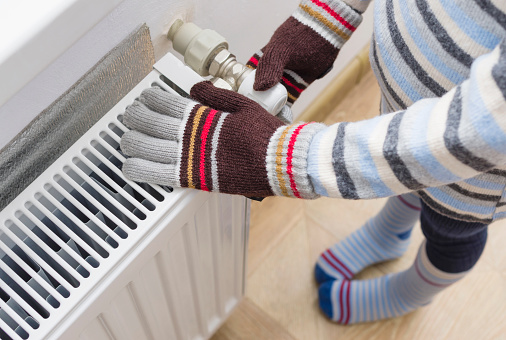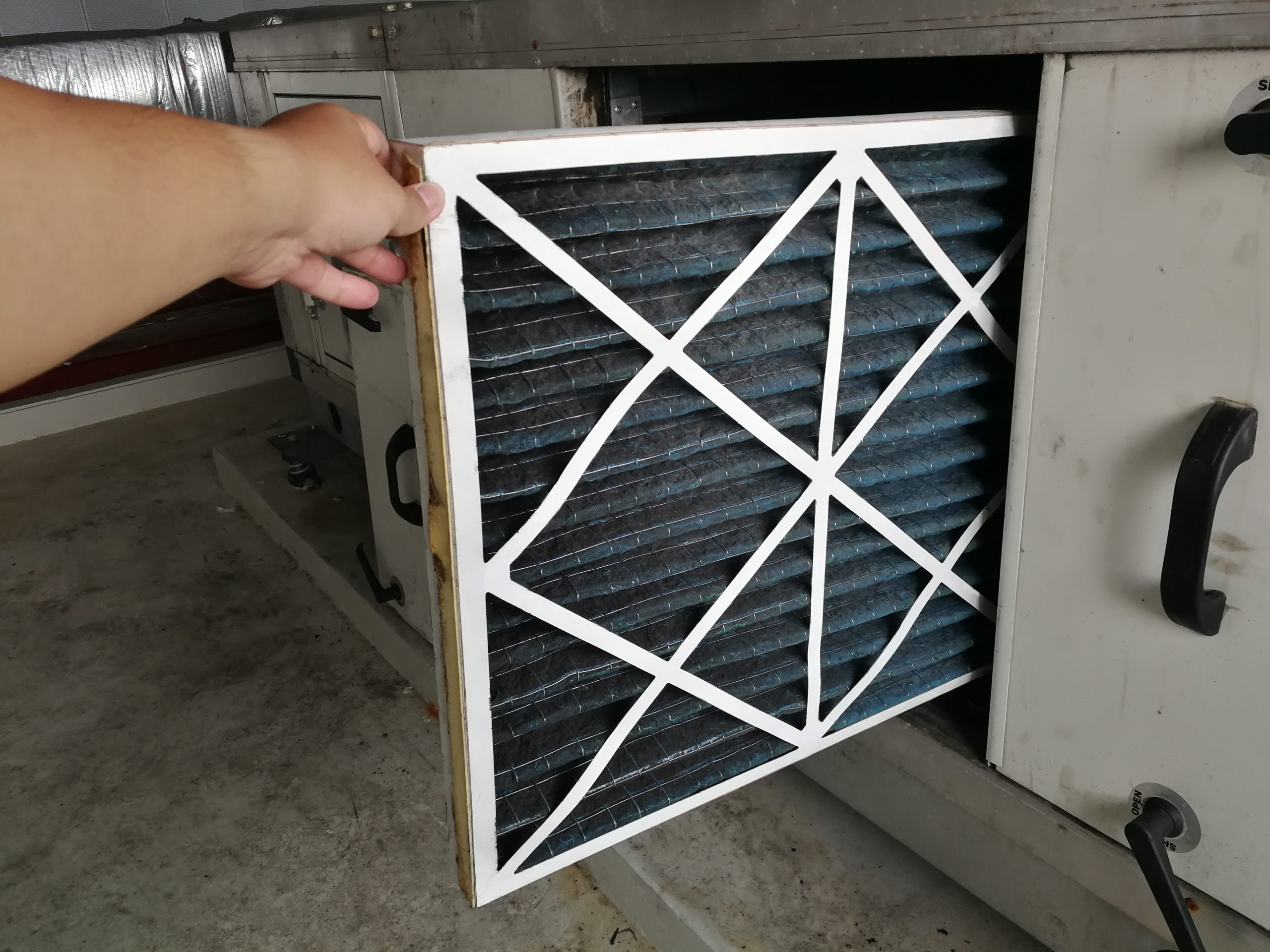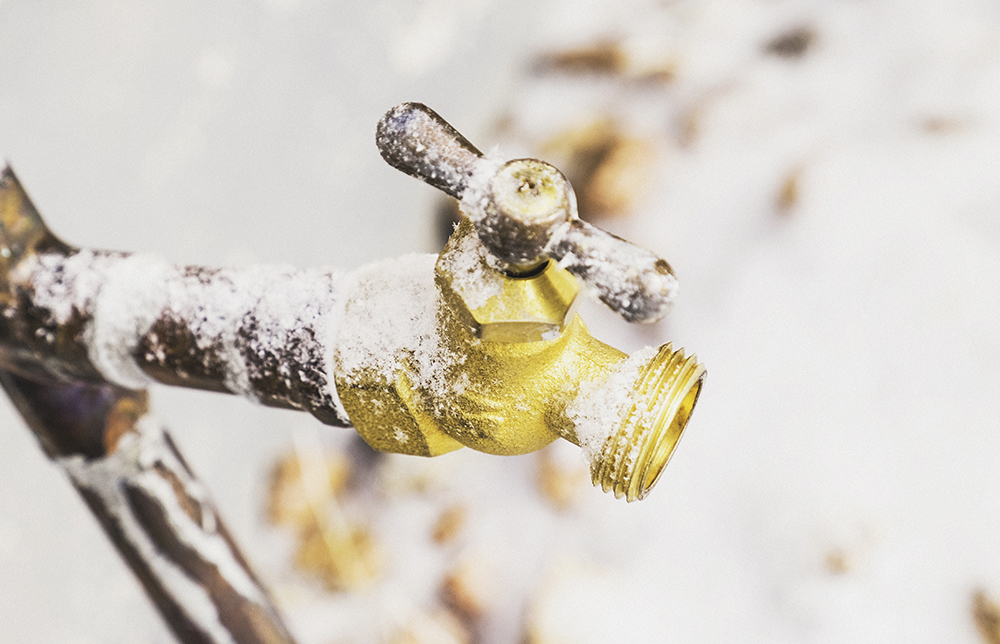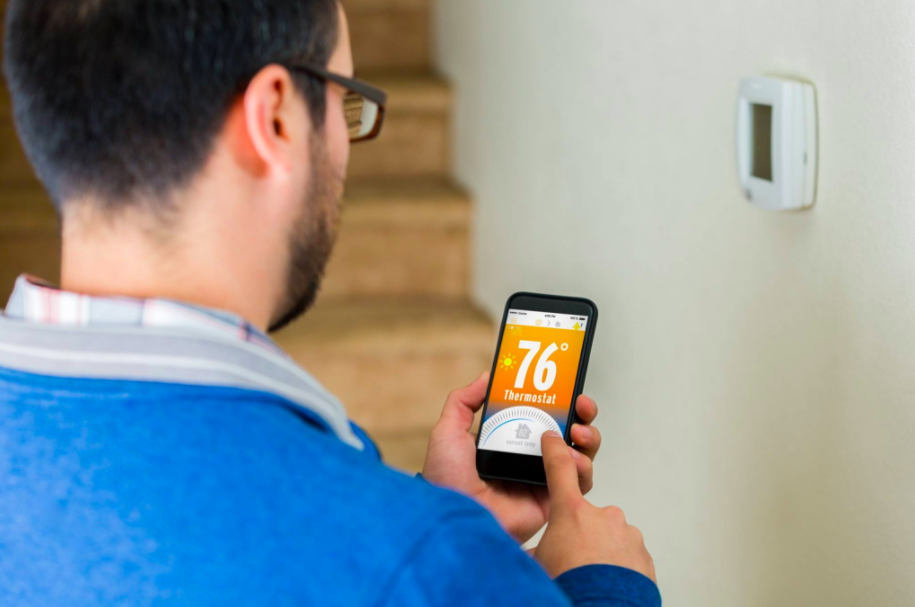Author Archives: 2010admin

Do you notice your water taking longer to heat up now that it’s colder? Are your showers lukewarm on the highest setting, leaving you shivering? As the coldest days of winter come around, it’s important to ensure your hot water heater is functioning properly to make sure you aren’t left out in the cold.
At Madsen Inc, we understand these issues happen. That’s why we recommend a routine inspection of your hot water heater at the end of summer or early fall so that you aren’t caught off guard with water that’s colder than the temps outside. But until then, here is a list of possible reasons that your hot water heater might not be functioning at its best, and a few easy ways to fix it!
Check the temperature on your hot water heater.
In the winter months, your heater is working harder to fight colder temperatures both outdoors and underground, so while the recommended thermostat setting is 120 degrees throughout the year to energy and ensure safety, this may not be enough to make your water feel hot enough in the winter months. Try adjusting your heater by 5 to 10 degrees and see if that improves performance.
Pro Tips:
- We recommend reading through your device manual before making any adjustments.
- Wait a bit after adjusting the thermostat to test your hot water – it usually takes about a half an hour for the heater to adjust to the new temperature.
- Be cautious! Change the temperature only a few degrees at a time to avoid scalding.
Drain the water tank.
Sediment buildup in the water tank is a common problem. It builds up naturally at the bottom of hot water heaters over time and can reduce your unit’s efficiency. Flushing it out at least once a year can prevent damage to your device and keep it functioning properly.
Check the age of your device.
Just call us with your model and serial numbers, and we’ll check if your hot water heater is still under warranty, or if it’s ready for replacement. You can also send us a picture of the plate or sticker on your device, and we’ll look it up for you.
Check if there’s a lack of insulation.
Make sure your pipes and heater are insulated properly as frozen or busted pipes can wreak all kinds of havoc in your home. Good insulation also makes it easier and faster to get hot water flowing when you turn it on. Not only does that mean less time waiting for that relaxing hot shower, but as an added bonus, it helps you conserve energy, saving you money on your water bill. Our team can help you with extra insulation if this is necessary.
Inspect the heater for any possible damage.
There is a possibility that your hot water system could be leaking. We do not recommend trying to fix a leak yourself — give us a call right away to prevent waste and potential further damage.
Other things you can do:
- If your hot water heater is in the basement or garage, try covering it with heater blanket. These specially made blankets can help insulate your tank in colder areas of your home where you can’t keep the temperature at least 55 degrees.
- To keep your pipes from freezing (and worst, potentially bursting), turn on your faucet and let it drip a little bit on especially cold days. Even just a small continuous stream of warm water can help prevent your pipes from ever reaching their freezing point.
At Madsen Inc, we’re here to help you make sure your water is exactly how you like it! If you have any questions or wish to schedule an appointment, contact us today.

Indoor air quality is a major aspect of home maintenance, but when most people think about air pollutants, they’re not thinking about inside their own home. Now, as we spend more time at home than ever before, using a quality ventilation system to maintain air freshness is key to keeping your air clean and safe for your family. Here are some tips for improving air quality in your home.
Why is Maintaining Air Quality Important?
- Having clean air in your home can help prevent harmful, short-term health effects, such as irritation of eyes, nose, and throat, headaches, coughing, sneezing, even dizziness.
- For residents exposed to unfiltered air for extended periods of time, the long-term effects could be respiratory disease (asthma or bronchitis), lung cancer, heart disease — with reported low birth weight in infants also reported.
- Properly filtered air minimizes the amount of secondhand smoke in your home, protecting your children and loved ones from respiratory issues and other harmful effects.
- Unvented kerosene heaters, wood stoves, gas water heaters, and central heating systems are common sources of carbon monoxide and nitrogen dioxide emissions inside a home. Keeping your air free of these types of harmful substances is extremely important to maintaining good health.
- Contaminated air can also facilitate airborne disease and viruses, allowing illness to spread easily inside any unfiltered space.
What Can You Do?
- Install an Air Scrubber.
Using air scrubbing technology, like The Air Scrubber Plus®, can help reduce the presence of particles and contaminants in your home’s air by 90%. The Air Scrubber Plus produces scrubber ions and hydro peroxides that remove contaminants such as mold, fungi, bacteria, and viruses. It also prevents dust buildup in your heating and cooling systems. The Air Scrubber Plus, along with most other air cleaners, can be easily installed directly into your HVAC system or existing ductwork. - Invest in an Energy Recovery Ventilator (ERV)
Making the investment now can significantly improve your air quality and save you money in the long run. The ERVs filter out toxins and particles in your air, and effectively reduce your AC dependency through their powerful heating and cooling recovery abilities. There is no need to compromise efficiency for clean air!
Other easy ways to improve air quality:
- Change Your HVAC Filter (& other air filters)
Your HVAC system works really hard all year round to keep you comfortable. Your air is constantly circulating, and your filters are designed to reduce the pollutants that circulate with it. But eventually, they’ll call it quits, causing major issues not only for your air quality but also for your system. Checking and replacing these filters regularly will help keep your air clean and your system from getting overworked, which means no costly repairs down the road for you.This also applies to all filters in your home, like your clothes dryer, kitchen vents, and vacuums — carpets and rugs can trap a lot of dust and particles, so keeping them clean is important for air quality too!
- Check Your Air Ducts
These passages are responsible for distributing hot and cold air throughout your home, but if not installed correctly or maintained properly, they can also be a source of all the harmful contaminants you don’t want to be breathing in on a daily basis. By hiring a professional — like the experts at Madsen — you can ensure your ducts are circulating fresh, clean air, while keeping your home as comfortable as possible. - Control the Humidity in Your Home
Exposure to mold can cause sore throat, skin rashes, wheezing, and a lot worse if gone untreated. Particularly in your kitchens and bathroom, keeping humidity levels under control is the best way to eliminate mold growth. Turn on the exhaust fan immediately after bathing, and turn on cooking vents or open a window when whipping up a delicious meal on the stove. This will also help eliminate various levels of carbon monoxide and nitrogen dioxide that electric burners can produce. Dehumidifiers are a good extra measure for the warmer months when humidity is at an all-time high.
At Madsen, our representatives will be happy to provide more information on protecting your family from germs, dust, and odors, as well as how we can install air cleaning systems in your home. Contact us today to begin your journey to fresh air!

While the winter season brings a flurry of wonderful things, freezing pipes is not one of them. No one has cracked pipes or water damage on their holiday wish list, yet too many people don’t take the steps to avoid a potential disaster. So before the cold strikes, follow these seven simple steps to prepare your pipes for winter and ensure the only thing overflowing this season is the eggnog.
- Have Your Plumbing Inspected
First things first, get your pipes checked! Anything we tell you after this first tip probably won’t help if your pipes are already very weak or damaged. With the increased pressure of freezing temperatures and heavy ice, your pipes are really put to the test, so before you do anything else, give your plumbing experts (like the Madsen Inc. team) a call. - Shut Off Outdoor Faucets
Shutting off your outdoors faucets is too often an overlooked necessity when it comes to winterizing your pipes. Turn these faucets off at their shutoff valves and open the bleeder cap to drain any water from the pipe to prevent it from sitting in your system. If you don’t, it’s much more likely to freeze and expand, cracking your pipes and causing long term damage. - Disconnect Your Hoses
If your hose is filled with water and left out in the cold, it will certainly freeze. And if it’s still connected to the faucet, it can become clogged with ice build-up, creating pressure that leads to pipe damage inside the home. Make sure your hoses are safely stored away for winter! - Cover Hose Bibs
Hose bibs are usually left unattended, which can cause them to burst as temps really drop overnight. Using an insulated hose bib cover will prevent heat loss and protect your outdoor faucets. They cost very little, and the damage they can prevent would cost you A LOT more. - Insulate Your Pipes
If water pipes run through an unheated part of your home—such as an attic, garage, or crawl space—installing a heat cable on vulnerable pipes and adding an insulating material like foam will help keep your pipes nice and warm. The heat cable is key to sensing pop temperature and turning on the heat as needed, while the foam insulation will ensure the warm air stays in. Simply run the cable over your pipe and wrap your insulator around it. - Use Your Water Often
A simple way to keep your pipes from freezing is to use your water on a regular basis. Even letting your faucet trickle a bit during a cold snap will help prevent freezing by relieving pressure that has built up in cold pipes. That’s because when you use your water, there is flow and stress relief in your pipes, which prevents cracking. What you may add to your water bill, you’ll totally make up for in not having a repair bill. - Seal Cracks and Gaps
Sealing gaps in doors and windows will quickly work to prevent excess cold air from reaching vulnerable pipes. A simple application of spray foam or caulk will keep air from sneaking in through cable holes, as well as any doors and window frame gaps throughout your home.
At Madsen Inc, we know the importance of pipe maintenance, but we also know it’s often the last thing on your mind, so to have your pipes inspected or for more information on winterizing your home, contact us today.

All of a sudden the days are shorter, the air is cooler, and the holidays are taking over your commercial breaks. That’s right, the holiday season is here, whether you’re ready or not. And for many of us this year, hosting family and friends will mean just a little more, filled with long-awaited reunions and unforgettable memories. So here are a couple things you can do starting right now to get your space ready for the best holiday yet.
What to Do Now
Inspect Your Appliances
It’s your biggest nightmare: you’ve spent all that time planning, cleaning, and decorating only to have your refrigerator go dark or the oven stop heating just before the guests arrive. That turkey won’t cook itself! Check all your appliances — dishwasher, oven, washer and dryer, etc.— for early signs of trouble (like a hissing sounds coming from the refrigerator), especially if you’ve had them for a number of years.
And when it comes to your heating system, you can ensure your home will be nice and comfortable all season long by having a professional from Madsen inspect your unit and make any necessary repairs. To make sure you and our guests aren’t stuck in the cold, give us a call today.
Upgrade the Shared Bathrooms
Your bathrooms already get a ton of daily use; now add a couple of guests in the mix, and it’s one of the most popular rooms in the house. The upcoming holidays are the perfect excuse to upgrade those hallway and guest baths for better functionality and a modern look.
And if a full renovation isn’t in the budget; try smaller upgrades like a new shower curtain, floor coverings, vanity lighting, or faucets and knobs.
Swap in Smart Thermostats
With a house full of people, it’s hard to please everyone. But smart thermostats basically do just that. Not only do they ensure your system is running properly, but through the use of room sensors, they help you manage hot and cold spots in all rooms throughout your house automatically. And with voice activation and Android/iOS connectivity, you can even pre-set or change any temperature settings in each room from in the car home from the store or with hands full of green bean casseroles.
A Few Weeks Out
Add Portable Accent Tables & Ottomans
While the drinks are flowing and the food is being served, small accent tables and ottomans really come in handy for you and your guests. You can never have too much surface space, and these portable options add flexibility without really disrupting the flow of the room. Elegant holiday trays add functionality with a nice touch of aesthetic to unstable upholstered pieces, while fitting naturally with your normal decor.
Spruce Up the Guest Bedroom
For those overnight guests, do a runthrough of the guest bedroom. Chances are this room doesn’t get much use, so make sure it’s equipped with everything your guests may need to make them feel comfortable. Double check there’s enough open storage for their belongings, add window treatments to prevent cold drafts at night, and swap out old bedding for a fresh look and feel.
To really be the hostess with the mostess, provide extra charging cords, make sure electrical outlets are easily visible, have shampoos/conditioners, hair dryers, towels, etc. already supplied so they don’t have to go out of their way to ask for them.
Do a Little Painting
It’s really amazing what a fresh coat of paint can do to a room. And there are a few key areas where a touch up can make an even bigger difference, such as the powder room, living room, and foyer. Whether you’re changing up the colors or just adding a fresh coat, focusing on these rooms will make the entire house feel a little more inviting and bright.
The Home Stretch
Decorate & Accessorize
Simple additions like fresh boughs or a few twinkling lights lining the front entry, some scented candles on the tables, and festive pillows and plants throughout the living spaces all have a big impact at low cost. Seasonal decor is always a nice touch to holiday gatherings, but even simply updating your rugs, throws, pillow covers, or towels will help your whole home look and feel refreshed.
Get Rid of the Clutter
The pressure is already on to get everything cleaned before the first guest arrives, so don’t add to the work by jumping over a pile of toys or shuffling around books and magazines; instead, start tossing or storing these items before you grab the Swiffer. It’ll make your job a lot easier!
For more tips on getting your home holiday ready or to see how our professionals can help, contact us to learn more. The countdown is on, so don’t wait!

Setting the right temperature for your home can be kinda frustrating. You want every room to feel comfortable, but you also don’t want to jack up utility bills or overwork your HVAC system. And during the transition between seasons, finding that optimal temperature can be even trickier. But we’re here to help! Check out the most efficient temperatures to set your thermostat in every season throughout the year.
- Bundling Up in the Dead of Winter
When the temp drops outside, don’t go crazy raising yours. In general during the winter, you want to keep your home at 72°F during the day and 68°F at night. You can obviously vary a degree or two based on your personal preferences, but staying within this range will help you maintain the most energy efficient temperature.
Even though temperatures can really drop at night, you don’t need your thermostat any higher than 68°F when you’re wrapped in the warmth of blankets and covers.
- Transitioning Between Seasons
For those liminal times when temperatures aren’t at either extreme, the rules are still generally the same: set your thermostat between 68°F and 72°F. Minimal heating or cooling is needed during these time periods, so even if it’s seasonably warm or cold one day, try to keep your thermostat around 68°F. This should allow you to feel comfortable, while reducing cost efficiency and reducing the strain put on your HVAC.
Also, keep in mind that making your home too warm in any season can increase humidity levels which can lead to other efficiency and air quality issues. Remember, blankets or layers are another great way to warm up without the risk — or the extra cash.
- When It’s a Real Scorcher Out There
We know when those heat waves hit, AC is everything. But you really don’t need your home to be 60°F or below to feel cool and comfortable. In fact, The U.S. Department of Energy recommends setting your thermostat to 78°F when you’re home in the summertime. Yep, 78.
But if that just doesn’t work for you, there are some ways to make sure you’re comfortable without really paying for it. Try investing in a smart thermostat, giving you the ability to adjust temperatures from anywhere. That way, you can crank up temps while you’re away, and then start the cooling process from wherever you are before you get home. For every degree you raise your thermostat above 72, you can save 3% of cooling costs, so you can balance out the expenses. These programmable thermostats also utilize room sensors to help manage hot and cold spots with free energy reports each month.
Also, keep in mind little things like turning on the ceiling fans, using dehumidifiers, and even shutting the blinds during the day are also inexpensive ways to keep your home cool.
- When No One’s Home
If you’re headed out of the house for an extended period of time, there’s no need to heat or cool an empty home. Again, smart or programmable thermostats allow your system to make the proper adjustments for optimal efficiency while you’re away using a pre-set schedule. You can store and repeat multiple daily settings (6+ temperature settings in a single day) for when you’re out of the house, in the home, or asleep. Get off work early? Extending your vacation? Don’t sweat it. You can also manually override any setting without affecting the rest of the daily or weekly program.
Now that you know the most efficient temperatures to keep you comfortable in any season, let Madsen make sure you have the right technology to make managing your thermostat easy. Our technicians specialize in the installation and service of the industry’s top digital brands in programmable thermostat, so you can set it and forget it. And we’re always here to answer any heating or temperature control questions you may have! Contact us today.


